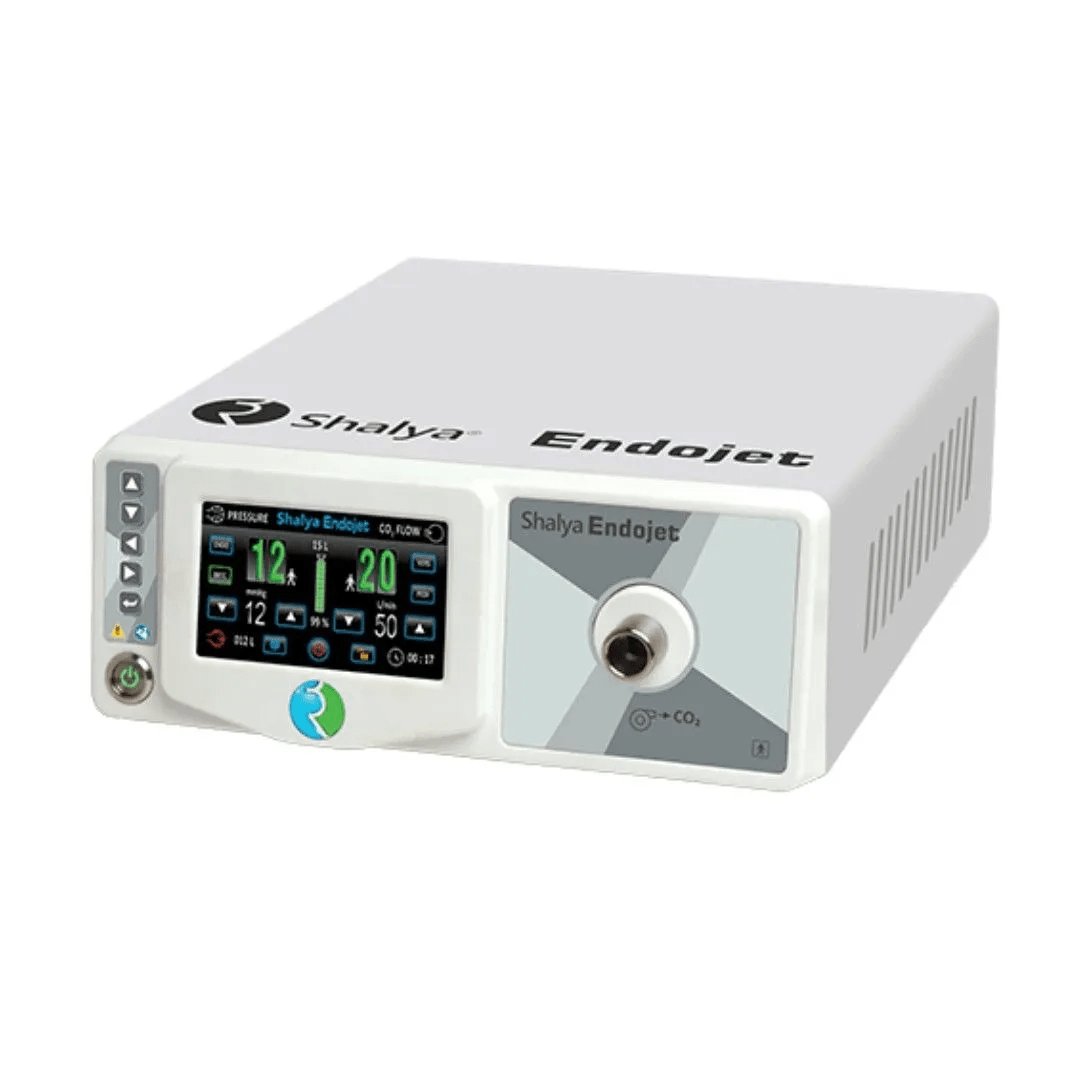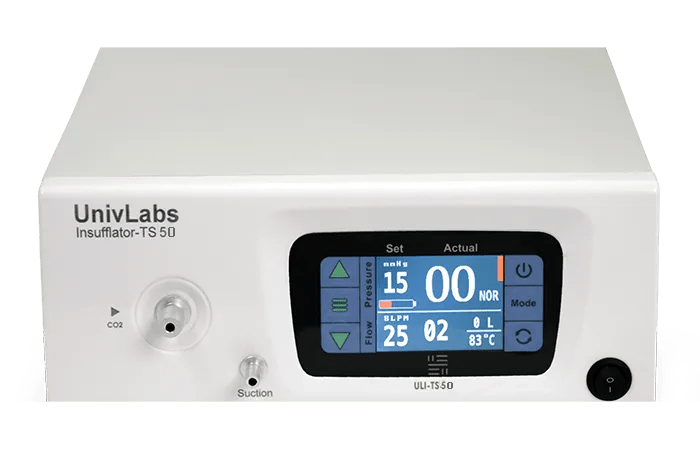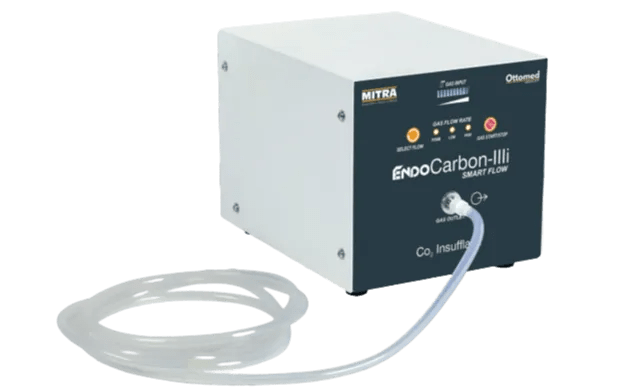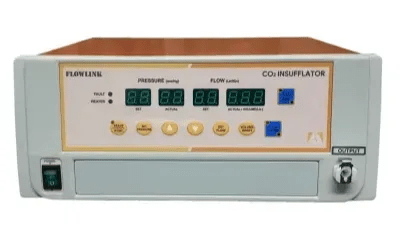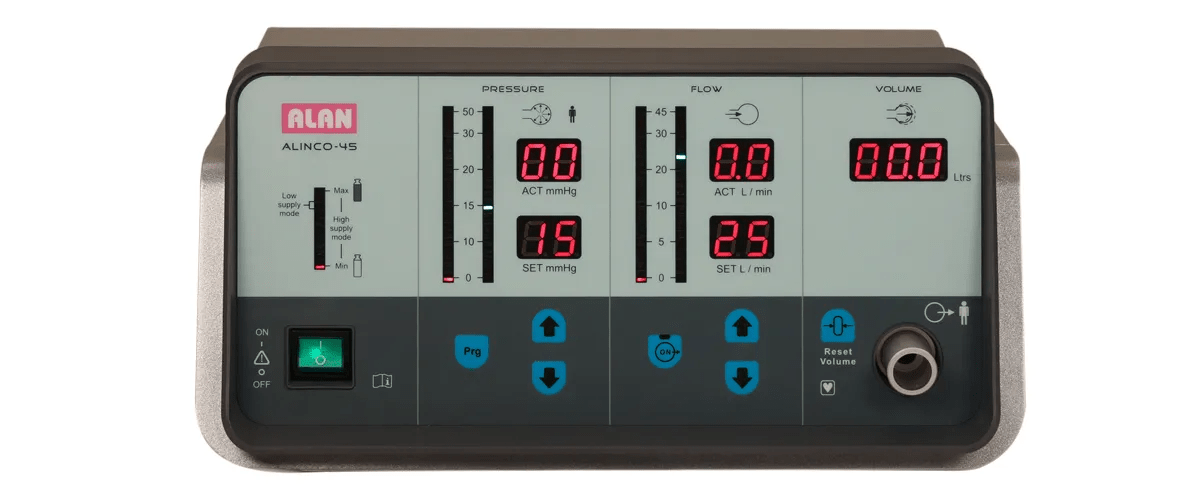Understanding the intricacies of medical equipment can indeed be a labyrinth. However, with a focus on patient comfort and operative visibility, one specific tool plays a significant role – the CO2 Insufflator. Standard in laparoscopic surgeries, the CO2 insufflator can transform a physician’s ability to clearly see and operate in an otherwise bloated labyrinth.
In essence, CO2 Insufflators are medical devices that facilitate the injection of Carbon Dioxide (CO2) into the body during surgical procedures, primarily during laparoscopy, to create a larger and more visible working space. Known for its rapid absorption and non-flammability, Carbon Dioxide neatly fits the bill for this purpose, helping to minimize complications and optimize patient comfort.
Purpose of CO2 Insufflators in Medical Procedures
The functions of a CO2 insufflator are multi-faceted:
- To create a pneumoperitoneum, a condition where gas or air accumulates in the abdominal cavity. This provides a larger space for surgeons to work, allowing for a broader view of internal structures.
- To maintain pressure inside the abdomen during the procedure, warding off potential collapses and ensuring continuity in visibility.
- To control the rate of CO2 flow, making sure the procedure remains safe while providing comfort to the patient.
Though bearing potential risks, CO2 insufflators’ contribution to minimally invasive surgeries like laparoscopy cannot be overlooked. Their benefits are, undoubtedly, major drivers for their usage in abdominal surgery.
Types of CO2 Insufflators
CO2 insufflators are an integral part of many hi-tech medical procedures given their pivotal role in creating a clear and safer path for surgical procedures. Understanding the types of CO2 insufflators is essential in understanding the functionality, design, uses, as well as applications, and capabilities of this device. Essentially, CO2 insufflators can be classified into three main types: High-pressure insufflators, Low-pressure insufflators, and Pneumatically automated insufflators.
High-Pressure Insufflators
High-pressure CO2 insufflators are primarily utilized in laparoscopic surgeries, where it is paramount to inflate the patient’s abdominal cavity. And in doing so, surgeons can have increased visibility and space to conduct the surgery. High-pressure insufflators:
- Works at a pressure range of 10-30 mmHg
- Ideal for procedures that demand fast insufflation
- Ensures better control as physicians can adjust the optimal CO2 pressure as per the requirement
Low-Pressure Insufflators
On the other side of the spectrum are low-pressure insufflators. They are typically used in less extensive surgical procedures where lower pressures and flow rates are acceptable.
- These insufflators function at a pressure range usually below 10mmHg
- Ideal for pediatric surgeries or delicate procedures
- Less tissue trauma and reduced risk of gas embolism
Pneumatically Automated Insufflators
Finally, we come to pneumatically automated insufflators. These unique insufflators are crafted to offer real-time pressure level adjustments that enable balanced insufflation suitable for a range of medical operations.
- Provides stable cavities for delicate procedures
- Prevention of excessive pressure build-up
- Capable of handling pressure fluctuations effectively
Understanding the variations of these insufflators is essential to appreciate their applications in ensuring safety, efficiency, and adaptability in different surgical settings. Each type comes with its unique set of features designed to meet the specific demands of various surgical procedures.
Benefits of CO2 Insufflators in Medical Procedures
CO2 insufflators prove a crucial advantage in multiple medical procedures. They assist in inflating the body cavity with carbon dioxide (CO2) gas, enabling surgeons to perform complex surgeries with greater precision and less invasiveness. Herein, two prime benefits of CO2 insufflators are presented.
Reducing Invasiveness of Procedures
CO2 insufflators are essential in minimally invasive surgeries. They create a larger, ‘distended’ space within the body cavity, giving surgeons better access to the operative area, hence:
- Lower risk of damaging surrounding tissues
- Decreased blood loss
- Reduced pain and shorter recovery time for patients
- Minimizes the risk of wound infections
Collectively, this leads to an overall increase in patient comfort and satisfaction, demonstrating why CO2 insufflators are the first choice in laparoscopic surgeries.
Improved Visualization and Accuracy During Surgeries
Beyond just creating space, CO2 insufflators also play a significant role in maintaining a clear, stable operative field. By inflating the body cavity with CO2, they prevent the intrusion of atmospheric air, which often causes:
- Fogging of the lens
- Impaired view
Hence, CO2 insufflators greatly enhance surgeons’ visibility and accuracy, leading to more successful surgical outcomes. This improved visualization is especially crucial in delicate procedures, such as cardiothoracic and neurological surgeries.
Risks and Considerations of Using CO2 Insufflators
Despite the many benefits of using CO2 insufflators in laparoscopic surgeries, it’s important to understand and take into consideration the potential risks and complications that can occur.
Potential Complications and Side Effects
Although CO2 insufflation minimizes surgical trauma, some side effects and complications can occur due to its use. Potential side effects from the use of CO2 include:
- Gas embolism can potentially lead to heart or lung complications if not recognized and managed properly.
- An increase in intrabdominal pressure leadings to decreased venous return and possibly reduced cardiac output, in rare cases.
- Mild to moderate respiratory acidosis due to an increase in CO2 absorption.
Proper Monitoring and Management of CO2 Levels During the Procedure
Managing and monitoring the levels of CO2 during medical procedures is a crucial aspect of patient safety. It is essential that the medical team constantly monitor the concentration of inhaled and exhaled CO2 and make timely adjustments to maintain systemic patient comfort and safety. Over- or under-insufflation can lead to complications, hence maintaining the just-right level of CO2 insufflation is crucial.
Precautions and Safety Measures for the Medical Team and Patients
Several precautions need to be taken to ensure patient and medical team safety during laparoscopic procedures. These include:
- Adequate ventilation systems to reduce potential CO2 exposure to the medical team.
- Careful gas evacuation after completion of the procedure, with immediate sealing of the trocar sites.
- Continual patient monitoring post-procedure to observe for any delayed complications or reactions related to the use of CO2.
Maintenance of CO2 Insufflators
Regular and comprehensive maintenance of CO2 insufflators is crucial for the longevity of the instrument and the safety of patients. The process primarily includes cleaning, disinfection, and troubleshooting common problems.
Regular Cleaning and Disinfection
Cleaning and disinfecting CO2 insufflators should be a routine activity in medical facilities. Routines should include daily, weekly, and monthly sanitation operations.
- Daily: Surfaces should be cleaned and wiped down at the close of each day. Any visible dirt, dust, or debris should be removed.
- Weekly: A more thorough cleaning should take place weekly. This includes cleaning hard-to-reach areas with specialized tools.
- Monthly: Complete a deep cleaning and disinfection of the device each month to ensure all potential sources of contamination are eradicated.
Following stringent cleanliness standards can significantly reduce the risk of cross-contamination and infection.
Maintenance Checks and Troubleshooting Common Problems
Routine maintenance checks should be conducted by skilled technicians. These checks help to pick up on early-stage wear and tear and address common problems such as calibration errors, gas leaks, or blockages.
Similarly, the CO2 insufflators should be thoroughly tested for functionality and safety parameters before every procedure. This routine maintenance can reduce the risk of device malfunctions during critical procedures, ensure the safety of patients, and prolong the lifespan of the device.
Common Problems and Solutions
In order to fully comprehend CO2 insufflators, it is necessary to identify and understand the common problems they may experience and the corresponding solutions to tackle these challenges, thereby ensuring optimal patient safety and surgical effectiveness.
Leakage issues
One of the common issues that practitioners often face with CO2 insufflators is gas leakage. This issue typically arises due to a broken seal or a problem with the connecting tubes. Liquid leaks may also occur and be indicative of internal mechanical faults. A leak could pose a potential risk of underinflation during surgery, which may inadvertently compromise the performance of a procedure and lead to suboptimal patient outcomes.
In order to rectify this:
- Regular inspections should be conducted to ensure the seals are fault-free.
- Replace the gas and liquid tubes routinely depending on the frequency of use.
- In the event of a leak, the insufflator in question should immediately be put out of service until the root cause of the leak is identified and addressed.
Blockages and Obstructions
The occurrence of blockages is another frequent challenge with CO2 insufflators. Such blockages may inhibit the free flow of gas, disrupting surgical operations.
Solutions to this problem include:
- Frequent cleaning and maintenance to eliminate possible debris or blockages.
- Visual inspections should be performed on the tubes to ensure they are obstruction-free.
- If a blockage is identified, take immediate corrective measures to remove the blockage.
Device Malfunctions and Error Codes
CO2 insufflators may occasionally present error codes which may signify a malfunction in the device. The interpretation and response to such error codes are integral to the proper functioning of the device. Often, these could present as irregular gas flow, disturbances in pressure levels, or fluctuations in temperature control.
To address such issues:
- Refer to the user manual for understanding the meaning behind each error code.
- Perform routine diagnostics to preemptively identify and resolve potential malfunctions.
- Contact the supplier or manufacturer in case of persisting malfunctions that can’t be managed on-site.
Limitations and potential challenges of CO2 insufflation
CO2 insufflation, despite its numerous benefits, has certain limitations and challenges that must be considered. These can often be classified according to the patient’s specific factors, surgical complexities, and available technologies.
Patient-specific factors affecting the use of CO2 insufflators
Patient-specific attributes can greatly influence the procedure’s outcome. For example, a patient with underlying lung or heart conditions can face increased risks. In these cases, rigorous preoperative evaluations must be conducted to ensure patient safety.
Furthermore, the patient’s posture during surgery can affect CO2 absorption rates with a potential increase in carbon dioxide levels in the blood, leading to respiratory acidosis. CO2 insufflation could also lead to capnothorax (the presence of CO2 in the pleural cavity) in patients with unidentified diaphragmatic defects. Hence, patient-specific factors are indeed a critical variable in the successful use of CO2 insufflations.
Surgical complexities and technical limitations
Beyond patient-specific factors, there are also surgical complexities to consider. For instance, the total insufflation pressure needed may vary based on abdominal characteristics, and suboptimal pressures can lead to complications such as abdominal discomfort or even injury. Likewise, longer surgery duration may increase CO2 absorption and subsequent risks.
Additionally, CO2 has a lower solubility than other gases, leading to the risk of gas embolism, albeit a small one. Technical skills to adequately handle such complications are a necessity, highlighting the importance of experienced surgical teams with specialized training in laparoscopic procedures.
Emerging technologies and potential alternatives
With the continuous advancement in medical technologies, alternatives to CO2 insufflation are emerging. Some are exploring the possibility of using helium or argon, which potentially offer reduced surgical risks. However, these alternatives lack the properties that make carbon dioxide ideal for insufflation such as rapid absorption and non-combustibility. Therefore, while it is important to stay open to new possibilities, it is also critical to thoroughly understand the potential risk-to-reward ratios in comparison to established methodologies such as CO2 insufflation.
Top Manufacturer’s Of CO2 Insufflators
Endojet E
The Endojet E – CO2 Insufflator, an innovative medical device offered by XcelLance Medical Technologies Pvt. Ltd., employs advanced technology to aid laparoscopic procedures. This cutting-edge insufflator is equipped with a user-friendly touchscreen interface, simplifying navigation and operation. Offering a high flow rate of up to 30 LPM, the Endojet E guarantees efficient insufflation for crucial surgical procedures. It furthermore comes with adjustable pressure settings reaching up to 30, permitting fine-tuned control for surgeons. Take advantage of its inbuilt high-pressure regulator and heater, ensuring optimal temperature management, and qualitatively enhancing surgical results.
UL-TS50
UL-TS50 insufflator, a flagship product from UnivLabs Technologies Pvt. Ltd., marries performance and safety with its patent-pending technology. Engineered in four distinct versions, the device caters to individual user requirements while its interactive capacitive touchscreen offers intuitive control. Experience expedited surgical procedures with the UL-TS50’s time-saving capabilities, drastically enhancing process efficiency. With an impressive flow rate up to 50 Litres per minute, the product offers outstanding support for surgeons, facilitating enhanced control over surgical procedures.
EndoCarbon-IIIi CO2 Insufflator
Mitra Industries Private Limited presents the EndoCarbon-IIIi CO2 Insufflator, a global leader among CO2 Insufflators manufacturers. This device plays a pivotal role in facilitating patient-friendly examination techniques that minimize discomfort and speed up recovery. Leveraging the fast absorption properties of CO2, it ensures minimal abdominal distension and pain. The intelligent mode increases the product’s efficiency, aiding in infection prevention, and promoting environmental conservation through efficient CO2 usage.
FLOWLINK
Monarch Healthcare brings to you FLOWLINK, a globally recognized in-demand CO2 Insufflator. Armed with multiple functionalities, FLOWLINK ensures consistency in CO2 pressure—a crucial factor in surgical procedures. Its internal gas heater system ensures optimal temperature management while its inbuilt overpressure release valve ensures safety during high-pressure conditions. Offering real-time data display and effective pressure and flow control, FLOWLINK is the ideal partner for all your CO2 insufflation needs.
ALINCO – 45 CO2 Insufflators
Designed and manufactured by Alan Electronic Systems Private Limited, the ALINCO – 45 – CO2 Insufflator showcases technological prowess in the field of medical devices. Utilizing an advanced microcontroller-based technology, ALINCO – 45 ensures precise CO2 insufflation, enhancing surgical efficacy. Its wide-ranging input compatibility allows for use on multiple international power systems without a stabilizer, thanks to its wide operating range design. Clarity in operation is guaranteed through independent and efficient display of various parameters such as set pressure and actual pressure, making it the ideal tool for professionals in endoscopic and laparoscopic surgeries.
Conclusion
The role of understanding and mindful usage of CO2 insufflators in medical procedures cannot be emphasized enough. To harness the maximum potential of these devices and to ensure patient safety, healthcare professionals must be conversant with their proper usage, maintenance procedures, and safety precautions. Recognizing common problems and resolving them promptly can also improve patient outcomes significantly.
Thus, in conclusion, CO2 insufflators, when used with a good understanding, contribute significantly to advances in modern medicine and enhance the effectiveness of minimally invasive surgeries.

